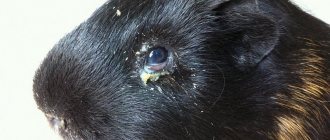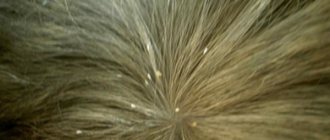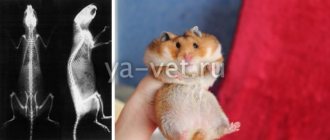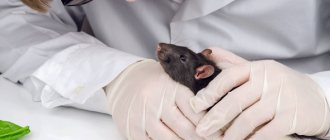Guinea pigs have long won the hearts of many. It is extremely difficult not to fall in love with these beauties, especially since there are a large number of their breeds. You can choose a pet for even the most capricious rodent lover.
Pigs live on average 8-10 years. But how long the animal will live in your home depends in almost all cases on the conditions of detention and proper care. If you feed and care for a rodent incorrectly, it will definitely get sick. How do you know if your guinea pig is sick and needs veterinary help?
How can you tell if your guinea pig is sick?
Guinea pigs, which many keep as pets, naturally have strong immunity, resistance and almost complete immunity to viral and bacterial diseases. With proper care and favorable conditions, cute, funny animals can live from 8 to 12 years. But still, do not forget that, like any other living beings, guinea pigs can become infected with any infection or disease. How to understand that an animal is sick?
A healthy pet has beautiful shiny fur, a good appetite, clean, clear eyes, and an expressive look. The animal is active, shows interest in the world around it, and responds adequately to external stimuli.
You can tell that a guinea pig is sick by its changed behavior and characteristic manifestations. The main symptoms of viral, bacterial, parasitic diseases:
- decreased activity, drowsiness, lethargy, depression;
- discharge from the nose, eyes;
- sudden weight loss;
- poor appetite, refusal of favorite treats;
- deterioration of coat condition;
- the presence of wounds, ulcers, abrasions, scratches, abscesses on the body;
- shortness of breath, cough, sneezing, difficulty breathing;
- change in heart rate;
- diarrhea, constipation;
- frequent urination;
- impaired coordination of movements;
- trembling, convulsions, muscle spasms;
- increased thirst;
- change in consistency, color, character of stool;
- change in behavior (lethargy, anxiety, aggression).
A guinea pig suffering from demodicosis.
A sick pet becomes inactive, depressed, tries to hide in secluded places in the cage or constantly sits in its house. The pig refuses food, does not take care of its hygiene, and does not respond to external stimuli.
Any of the above signs or a combination of them should alert owners. If your guinea pig is sick, your pet's condition worsens; you should not self-medicate. Some infections have an aggressive course and can cause the death of your beloved pet. In addition, some animal diseases are transmitted to people (rabies, tuberculosis, pasteurellosis), so if the animal gets sick, consult a veterinarian. The specialist will make a diagnosis and select effective treatment.
Causes of mumps (mumps)
Mumps most often affects children aged 3 to 15 years . Until one year of age, a child has innate immunity received from the mother’s body. In the absence of immunity acquired in childhood, an adult can also get mumps.
The infection is transmitted by airborne droplets
. Getting into the respiratory system along with tiny particles of mucus, the virus penetrates the blood and is transferred by the blood stream to the salivary glands. At the same time, the virus can penetrate other organs through the blood, which makes mumps a dangerous disease.
The virus is relatively stable in the external environment and can exist on toys, dishes, and household items; dies in the cold and during disinfection. However, since there are no catarrhal symptoms in mumps, the penetration of the virus into the external environment is negligible. The situation gets worse if, in parallel with mumps, the child gets a cold. In this case, the risk of spreading the infection increases.
The incubation period for mumps is from 11 to 23 days (usually 13-19 days). The patient is contagious from the last two days of the incubation period until 9 days after the onset of the first symptoms.
Infectious diseases
Infectious diseases are caused by viruses, bacteria, and simple pathogenic microorganisms. A guinea pig can become infected from other pets, its relatives, or latent virus carriers. Infection occurs predominantly by contact, airborne droplets, and nutritional routes. Intrauterine infection is possible, in which the fetuses become infected in the womb.
Viral-bacterial infections diagnosed in guinea pigs can develop against the background of hypo-vitaminosis, stress, unbalanced feeding, due to a decrease in immune potential, resistance.
Plague
Plague is a deadly infection for guinea pigs. Characterized by lightning-fast development and high mortality. The incubation period lasts from several days to 3 weeks.
Symptoms:
- indigestion;
- diarrhea, vomiting;
- mucous, purulent discharge from the eyes;
- lethargy, apathy, drowsiness;
- lack of coordination;
- slight trembling;
- seizures, convulsions;
- pallor of mucous membranes.
Unfortunately, no treatment has been developed for this infection, and the guinea pig is euthanized.
Pseudotuberculosis
The disease is characterized by high mortality, aggressive course, digestive disorders, shortness of breath, and difficulty breathing. At autopsy, small dense nodules are found in the internal organs, which resemble tuberculous tubercles. Infection occurs through the nutritional route.
Main symptoms:
- profuse diarrhea;
- weight loss;
- lack of appetite;
- drowsiness, lethargy, depression;
- deterioration of coat;
- profuse discharge from the eyes and nose;
- dirty, wet fur near the anus;
- convulsions.
Feces have a watery consistency, contain mucus, foam, bloody substances, and emit a sharp, specific odor. In the early stages, if you start treatment, you can save and cure your pet. Broad-spectrum antibiotics and sulfonamides are used in therapy.
Paratyphoid
Infection can be transmitted through food and water contaminated with bacteria. The disease occurs in acute, subacute, and less commonly, chronic form. Main symptoms: tousled fur, loss of appetite, sudden weight loss, green diarrhea, drowsiness, depression, inactivity.
When diagnosing paratyphoid fever, the treatment for a guinea pig will be determined by a veterinarian. The animal is prescribed complex antibacterial drugs, tetracycline antibiotics, homeopathic remedies, antityphoid serum, sulfadimezin. Medicines are given with food or dissolved in water.
Lymphocytic choriomeningitis
A fairly common disease in guinea pigs, which often causes the death of pets. The disease progresses at lightning speed. The duration of the incubation period ranges from 35–42 hours to 5–6 days. In rare cases, the infection becomes latent.
In sick animals, the temperature rises, regional lymph nodes enlarge, and coordination of movements is impaired. The pet becomes inactive and refuses to eat. Once the diagnosis is confirmed in the laboratory, the guinea pig is euthanized.
Bordetellosis
As a rule, guinea pigs become infected through direct contact with other pets. Dogs, cats, rodents can be carriers of a dangerous virus. The disease is manifested by changes and disturbances in the functioning of the respiratory tract and is characterized by shortness of breath, frequent shallow breathing, cough, profuse catarrhal-serous discharge from the nose and eyes, conjunctivitis, and lethargy. A sick pig throws its head to the side, rubs its muzzle with its paws, shows anxiety and can become aggressive. Appetite is reduced or completely absent.
Treatment for a guinea pig should be comprehensive. Antibacterial agents, sulfonamides, complex symptomatic, and restorative drugs are used in therapy. Good results are noted after intramuscular administration of Baytril and Gentamicin (4–5 mg/kg). The dosage and duration of the course will be prescribed by your veterinarian.
Pasteurellosis
The infection is manifested by general depression, weakness, lack of appetite, increased thirst, tearfulness, and sneezing. Near the nose, the fur is moist due to abundant mucous or purulent discharge. The guinea pig is rapidly losing weight and breathing heavily. When auscultating the sternum, murmurs are clearly audible. The fur becomes brittle and matte. Ulcers appear on the body in various places. If the inflammatory process extends into the deep layers of the dermis, blood poisoning is possible.
The disease can last for months and periodically worsen under the influence of concomitant unfavorable factors due to decreased immunity. Treatment has not been developed, and the pig dies due to intoxication, exhaustion, and sepsis.
Pathologies of internal organs
Very often these animals experience problems with their digestive system. There are many reasons, for example, poor nutrition, infections, and even hypothermia. Often, owners observe diarrhea, bloating, or constipation in their pet. The animal begins to feel unwell, moves less, apathy appears, and appetite decreases.
Bloating is also observed - tympany, during which fermentation occurs in the intestines and gas formation increases. It can occur due to malnutrition, and is also often observed in the spring.
When bloated, the tummy increases in size and the heart rate increases. Due to the fact that gases put pressure on the diaphragm and lungs, shortness of breath is possible. The animal experiences pain and therefore grinds its teeth and squeals.
To get rid of bloating, use dill water, which is sold in pharmacies, and chamomile decoction also helps. You need to stroke the animal's belly with light movements from top to bottom. If the chewer refuses to eat, he is given baby formula, but only lactose-free. It is imperative to subsequently restore the intestinal microflora; probiotics are used for this.
Also, guinea pigs may have constipation, which is often associated with poor nutrition, namely, when there is not enough or no succulent food in the diet, not enough rare meals, not enough water.
With constipation, you can observe a decrease in the amount of feces, the rodent arches its back and takes an unnatural position. You need to add Vaseline or castor oil to the water and give it to your pet. Afterwards, be sure to give a chamomile decoction. If constipation is observed regularly, this may indicate serious illnesses, intestinal adhesions, tumors, etc.
Cystitis
This is a disease in which inflammation of the bladder occurs. It occurs quite often, the causes can be colds, hypothermia, poor diet, which reduces immunity, and infection in the urinary organs. Be sure to regularly change the litter and make sure it is not damp or wet.
Signs of cystitis are:
- Restless behavior.
- The animal tries to urinate frequently, but most attempts are unsuccessful.
- During urination, the animal squeaks in pain.
- Traces of blood are visible in the urine.
In the treatment of cystitis, antibiotics are used, as well as sulfonamides, prescribed by the doctor according to test results and other individual indications.
Diuretics are also prescribed; decoctions of lingonberry leaves, bearberry and kidney tea help well. If the rodent's condition does not improve, be sure to do an ultrasound to rule out urolithiasis.
Breathing diseases
If a guinea pig is not properly cared for, has an allergic reaction to food, has suffered hypothermia, or has been infected by a virus or bacteria, the animal may encounter respiratory diseases, which include rhinitis, pneumonia, tracheobronchitis, and pulmonary edema.
You should pay attention to the following signs:
- Purulent and mucous discharge appears from the nose.
- Sneezing.
- Wheezing.
- Shortness of breath.
- Breathing quickens.
If you have such symptoms, you should definitely contact your veterinarian to make a correct diagnosis and prescribe treatment. You cannot diagnose the disease yourself, much less treat it, as this can cause even more harm.
Diseases caused by parasites
Invasive diseases in guinea pigs are caused by external and internal parasites. Infection occurs through contact and nutritional routes. The most common diagnoses for guinea pigs include worms, fascioliasis, and coccidiosis.
Fascioliasis
The disease is caused by parasitic liver fluke worms. The disease is manifested by lethargy, apathy, drowsiness, yellowness of the skin and mucous membranes, and signs of intoxication. Sick pets completely refuse water and food, quickly lose weight, and look severely exhausted.
Unfortunately, this pathology manifests itself in the later stages of the development of the disease, after autopsy, so fascioliasis is detected in most cases posthumously. To prevent the development of the disease, several times a year for preventive purposes you need to give your pets anthelmintic drugs (Praziquantel), strictly adhering to the dosage indicated in the instructions.
Coccidiosis
The disease is caused by single-celled parasites - Eimeria from the genus Coccidia. Young animals with an immature or weakened immune system are at risk. Adult animals develop immunity to a certain type of coccidia.
A characteristic symptom is indigestion (diarrhea followed by constipation, vomiting, lack of appetite). The feces contain mucus, foam, and particles of undigested food. In advanced cases, bloody spots may be seen in the stool.
In sick pets, diuresis increases, which can be understood by the bedding quickly becoming contaminated with feces. Animals lose weight and are severely depressed. Mucous membranes are pale, cyanotic. The abdomen is increased in volume. The fur near the anus is wet, dirty, and matted. When palpating the peritoneum, the animals experience severe discomfort and pain.
Having noticed the first symptoms, put your pet in another cage; if the animal is kept in a pair, contact a veterinarian who will tell you how to treat this disease. Ditrim, Furazolidone, Himcoccid, Sulfadimezin are used in therapeutic therapy. Medicines are added to drinking water in recommended dosages.
External parasites, skin diseases
Among external parasites, a guinea pig can be infected with fleas, lice eaters, and ticks. Ectoparasites provoke flea dermatitis and allergies. Parasitic diseases are manifested by anxiety, nervousness, severe itching, and sleep disturbances. On the body you can notice a rash, red small spots, hairless areas, dandruff, scratching. The coat becomes dull and loses its natural shine.
Skin diseases in guinea pigs require an integrated approach. The choice of drugs depends on the form, stage, and cause of dermatological pathologies.
Pets are prescribed insecticide-acaricidal drops, antiparasitic shampoos, ointments, and antibiotic-based liniments. In addition to the main treatment, the diet is adjusted and the cage is disinfected.
Peeling skin is a symptom of ectoparasite infection
Tumors
Neoplasms are usually diagnosed in adults. Generally, guinea pigs suffer from breast and skin cancer. In most cases, breast tumors are operable and the prognosis is favorable.
Skin cancers may appear as a lump on the back and can be removed surgically. With this course, metastases are not observed. The development of skin cancer may also be indicated by the appearance of spots on the hind legs. In this case, the prognosis is less favorable.
There are a variety of diseases observed in guinea pigs, and it is quite difficult to diagnose them at home. Therefore, if your pet has health problems, you should contact a specialist who will tell you what to do.
Non-communicable diseases
Diseases of non-infectious etiopathogenesis pose no less danger to the health and life of guinea pigs. A deficiency of nutrients leads to metabolic disorders, rickets, hypo- and avitaminosis, and provokes digestive problems and hormonal imbalances.
The main symptoms of rickets and vitamin deficiency:
- disturbances in growth and development;
- poor coat condition;
- thickening of joints;
- sagging back;
- curvature of limbs;
- impaired coordination of movements;
- convulsions, muscle spasms, paralysis;
- nervous disorders, increased excitability.
If a pig suffers from rickets, hypo-vitaminosis, or vitamin deficiency, the animals are prescribed multivitamin complexes and mineral-vitamin mixtures. Add 2-3 drops of Tetravit and Trivitamin to drinking water daily. Adjust the diet.
Hypothermia and stress weaken the body and can cause not only respiratory ailments, but also cystitis, stone disease, and other pathologies of the excretory system.
Avitaminosis
With cystitis or inflammation of the bladder, urination becomes more frequent, pets become inactive, and hide in secluded places in the cage. Mucous membranes are anemic, pale. Urine takes on a brown, red-brown hue. Upon detailed examination, you can see bloody threads, clots, and fibrin flakes in the urine. Treatment is carried out with antibiotics, antispasmodics, sulfonamides, and homeopathy. The veterinarian will select treatment depending on the underlying cause.
In older animals, benign and malignant neoplasms are detected. If the cancer has not metastasized and is characterized by a benign course, surgical treatment is prescribed in which the tumor is removed.
Due to injury, animals receive various injuries in fights with relatives. A fall from a height can cause deep wounds, fractures, ruptures, sprained ligaments and tendons.
For wounds and ulcers, drugs for local treatment are prescribed (ointments, gels, liniments, pharmaceutical mash), antiseptic solutions, suspensions, as well as symptomatic drugs to normalize the general condition.
For purulent abscesses, ulcers, wounds, Vishnevsky's liniment and streptomycin ointment are applied to the affected areas. Before applying the drug, the hair near the lesion is cut off. The damaged surface is treated with an antiseptic (hydrogen peroxide), foreign objects are removed, crusts and scabs are removed. After applying the ointment, apply a fixing bandage.
Other violations
An animal may experience baldness; there are several reasons for this condition, for example, a lack of vitamins, an allergic reaction, or a parasitic infection. If the diet contains a small amount of hay, the rodent may eat its fur; in this situation, you need to add dry grass to the feeder.
If a female experiences baldness on her sides and abdomen, this may indicate hormonal imbalances, as well as the formation of an ovarian cyst. Hair may fall out due to stress. They can experience stress for many reasons: new premises, new relatives, poor treatment, etc.
Of course, an animal can get injured, often due to the fact that the animal is not properly cared for. They can fall, they can be stepped on, in addition, fidgets can injure themselves when they run around the cage and hit their paw on the cage.
Remember that these animals have a very weak spine and a fall from a small height can lead to a fracture. If you notice that the rodent does not rest on its paw, is limping, or is only resting on its front legs, immediately go to the doctor.
Gastrointestinal diseases
The development of diseases of the digestive system is facilitated by poor-quality nutrition, an unbalanced diet, and a deficiency of vitamins, macro-, and microelements. Pathologies can occur against the background of viral, bacterial, parasitic infections and diseases (helminthic infestations, poisoning).
An unbalanced diet and exposure to toxins provoke food allergies and severe poisoning. Gastrointestinal diseases in guinea pigs are manifested by unstable stool (diarrhea, constipation), weakness, lethargy, decreased appetite, refusal of favorite treats, vomiting, weight loss, and decreased activity.
Stomach upset in mumps
Helminths, which can live in the intestines, liver, lungs, heart, liver, pancreas, disrupt metabolic processes, interfere with the absorption of nutrients, poison the body with toxins, provoke disturbances in the functioning of internal organs and systems, and can cause seizures and convulsions. A piglet infested with worms can die from a nervous attack, severe exhaustion, severe intoxication, or intestinal blockage.
Treatment and the choice of methods depend on the form, stage of the disease, and the root cause. Animals are prescribed absorbents, restoratives, symptomatic medications, antibiotics, enzymes, probiotics, homeopathic remedies, and decoctions of medicinal plants. For diarrhea, Fthalazol, Enterosgel, Enterosperol are prescribed. You can give your pet rice water or strong tea. Flax seed, chamomile tea, and herbal infusions will help normalize digestion.
Diagnostics
Don't hesitate if you see an animal acting strangely.
Take him to the veterinarian immediately - only he will be able to recognize the disease.
But, of course, you must be able to distinguish a sick rodent.
Diseases found in guinea pigs are divided into several types:
- defects caused by heredity;
- a number of parasitic diseases;
- diseases caused by improper feeding, as well as the composition of food feed;
- infections;
- all kinds of mechanical injuries.
Symptoms
If you notice a pig:
- other behavior;
- the pig often lies down with its eyes closed;
- difficulty breathing, rapid breathing, cough;
- high thirst;
- the coat is strange - shaggy, matted or falling out;
Almost all animal diseases occur in reduced physical activity. Pigs are no exception: they strive to retire, hide, and lie down.
suppuration of the eyelids; there are ulcers on the surface of the skin; there may be a runny nose, along with various nasal discharge; frequent dry/loose stools (often); paralysis or seizures; small insects in the fur (lice and fleas), contact your veterinarian.
Let's look at the most famous and common diseases of pigs.
Eye diseases in guinea pigs
Keratitis, conjunctivitis, uveitis, corneal ulcers, entropion, inflammation of the eyelids are ophthalmological diseases often diagnosed in guinea pigs. They can be congenital or occur due to mechanical damage, trauma, as well as secondary infections and diseases.
When the mucous membranes of pigs become inflamed, the eyes fester and the eyelids swell. Animals are afraid of bright light, become restless or, conversely, very depressed and inactive. Due to abundant mucous, catarrhal, purulent discharge, the fur on the face is constantly wet. Dry crusts appear near the eyes or in the corners. In severe cases, clouding of the cornea, decreased visual function, and complete or partial blindness are noted.
Corneal lesion
Symptoms depend on the cause, form, localization of the pathological process or inflammation. Treatment is carried out comprehensively. They are used for general and local treatment. The conjunctiva is washed with disinfectant solutions. Medicinal anti-inflammatory and antibacterial drops are instilled into the eyes, and medicinal ointments (tetracycline, chloramphenicol) are applied.
If the eye disease is caused by an infection, the sick pet is prescribed antibiotic therapy. Systemic antibiotics of complex action are used. Treatment of guinea pigs is carried out until complete recovery and normalization of general condition.
Diseases of the teeth and oral cavity
Any dental pathology interferes with food intake, so the animal loses weight and develops vitamin deficiency. There is profuse salivation, as a result of which the muzzle becomes wet.
Causes of the anomaly: grinding of the incisors is disrupted, hooks appear on the molars. With any of these pathologies, the mucous membrane of the oral cavity is injured, which causes pain and interferes with food intake. Treatment is carried out by correcting dental abnormalities.
Cheilitis is inflammation of the mucous membrane and border of the lips. More often it is a consequence of vitamin deficiency, infectious pathology, parasitism of a special type of mites that live on the upper palate. Crusts, cracks, and ulcers form on the lips and in the oral cavity, and a copious greenish coating is deposited on the teeth.
Ear diseases
If the guinea pig shakes its head, constantly rubs its muzzle with its paw, has become inactive, a large amount of wax and dark crusts are noticeable inside the ear, you can suspect that the pet has otitis media. The disease can be caused by mites, viruses, bacteria, fungi, or foreign objects entering the ear canal that cause inflammation.
With otitis media, the temperature rises. The inner surface of the auricle is hyperemic and inflamed. A sharp, specific smell emanates from the ears. On the outer surface you can see wounds, scratches, scratches. With bilateral otitis, the guinea pig becomes lethargic, stretches its neck forward or tilts its head to the side. When examining the ear, redness and severe pain are noted. Dry dark crusts, scabs, and ulcers are visible inside the ear.
Otitis media is very often complicated by pathogenic flora and can cause deterioration, partial or complete loss of hearing function, so treatment must be started immediately.
Animals are prescribed antibacterial medicinal drops, solutions, lotions, and symptomatic medications for general treatment. Before instillation of the ear, the ear canal is cleaned of contamination using antiseptics, and crusts and wax are carefully removed with a sterile cotton-gauze pad. All manipulations are carried out very carefully to avoid damage to the eardrum. Topical medications are instilled into each ear of the pet.
Respiratory system diseases
Respiratory diseases in guinea pigs develop due to decreased immunity, severe hypothermia, and exposure to drafts. They are manifested by general weakness, lethargy, impairment, depression of respiratory function, coughing, sneezing, fever, chills, fever, purulent, mucous, catarrhal discharge from the eyes. Animals are inactive and react sluggishly to external stimuli.
Treatment must be prescribed by a veterinarian
During treatment, owners must strictly follow all recommendations of the treating veterinarian. Before giving your pet medication, carefully read the instructions for the medication. Stick to the indicated dosage. During treatment, as well as after treatment, carefully monitor the behavior and health of your pet.
We invite you to join our Zen channel and group on VKontakte or Odnoklassniki, where new articles for pet owners are published.
Similar articles:
- The simplest things that can harm a guinea pig
- Djungarian hamster at home: advice for the future owner
- How to organize leisure time for a guinea pig?
Treatment
Fungus in guinea pigs can be eliminated only by regularly cleaning the pet’s home and changing the bedding. This is also required for prevention. High-quality feed must be added to the animal’s diet. The pet must be protected from high humidity.
When a fungus is detected, the sick animal is placed in a separate cage. The dwelling where the guinea pig used to live must be treated with chlorine.
First you need to normalize the animal's diet. Since the disease usually occurs with reduced immunity, the animal’s menu should include healthy foods that will saturate the body with valuable vitamins and minerals.
The pig is shaved with a clipper if the affected areas are large. And if they are small, they simply cut off the hair near the fungus. Trimming or shaving is required to prevent diseased scales from spreading.
Nizoral shampoo, which can be bought at a pharmacy, is effective in treatment. With its help, you can eliminate fungal infection, itching, and peeling. The shampoo is applied to the affected areas, leaving for a few minutes. Then you just need to wash it off.
Fungoterbin cream 1% is an effective remedy with antifungal properties. The drug disrupts the biosynthesis of ergosterol in fungi. This is how squalene accumulates in cells, causing its cells to die. Symptoms become less pronounced at the beginning of treatment.
Thermikon cream 1% is an antifungal agent. It disrupts the synthesis of ergosterol. This is how squalene accumulates in the cells, so the fungus disappears.
Fukortsin - solution is used for external use. The product has antimicrobial and antifungal properties. After just a few treatments, the symptoms become less pronounced.
Before using any drug, you must read the instructions
It is important to strictly follow the veterinarian’s prescriptions, dosages and duration of treatment. This guarantees quick and effective removal of fungus.
Authors of the articles: Belanta Clinic team











